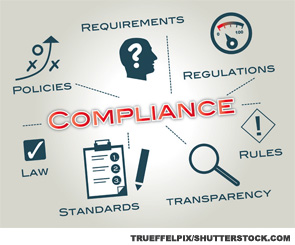
The necessity for medical practices to develop and implement an effective compliance program is transitioning from voluntary to mandatory, based on the requirements in the Patient Protection and Affordable Care Act (PPACA). In 2010, the PPACA requirement specified that healthcare providers applying to enroll as a participating Medicare provider should have a compliance program in their practice and a compliance point of contact.
The term compliance has been a buzzword in the medical arena for more than a decade, but now, more than ever, it’s becoming a set guideline. There is a growing demand to control fraud, waste and abuse, as well as the national healthcare expenditure, which topped $2.7 trillion in 2012.1 The Office of Inspector General (OIG) has indicated that a compliance plan lays the groundwork for helping physician practices avoid confusion when handling coding, billing and other legal and compliance issues for patient services.
Compliance is one of the biggest risk areas for physician practices, and it’s important to understand that this is an expanding area of the law that, if ignored, has the potential to expose your practice to more risk. The key to making a compliance plan a part of your practice culture is to make it truly effective: It must be more than a document that is reviewed once a year. The OIG’s guidance to physician practices emphasizes that a compliance plan must be an active program—not just a written set of standards and procedures that sits on a shelf. A compliance program or plan should be an integral part of your daily practice operations.
The OIG recommends seven specific components for a healthcare compliance program:
- Conduct internal monitoring and auditing;
- Develop and implement a compliance program and practice standards;
- Designate a compliance officer or contact person;
- Conduct appropriate training and education for staff;
- Respond appropriately to detected offenses, and develop corrective action;
- Develop open lines of communication; and
- Enforce disciplinary standards in the practice through well-publicized guidelines.
Conduct Internal Monitoring & Auditing
A successful compliance review begins with an ongoing evaluation process. It’s vital to have a certified coder or biller to perform internal audits and monitor the accuracy of claims prior to submitting. Having a certified coder/biller is important, because the individual will need to be familiar with all the billing and coding guidelines so if errors are found they will know how to correct and resubmit the claim. Additionally, internal monitoring and auditing should not be performed only one time, but recurring and regular audits will give the provider an ongoing opportunity to assess what is being billed and minimize any risks. Each year, the compliance officer or staff should review the OIG’s Work Plan to see where they should concentrate their efforts when performing audits.
Implement Compliance & Practice Standards
Verify that your compliance plan addresses how the practice will review and handle any risk areas. There should be a periodic review of the policies and procedures of the organization, because this will provide the opportunity to revise and update them if necessary. To develop a comprehensive and significant set of policies and procedures, the provider, along with the practice manager and other key staff, should consider potential areas that are weak or have regulatory exposure and make adjustments to the policy to respond to these areas.

